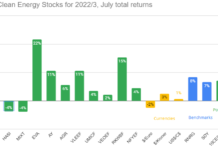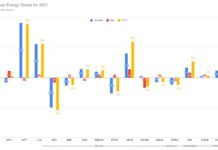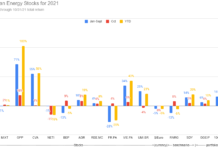Tom Konrad CFA
Corrected version 8/11/2011
Apologies to readers who have been missing my articles recently. I’ve had little time to write as I have been too busy trading. Long-time readers know that I’ve been bearish since the summer of 2009, and it has been a painful two years as I maintained my short positions and puts in the face of a generally rising market.
Market Outlook
In my opinion, we are still a good distance from the bottom. The rise of the stock market over the last two years has been predicated on stimulus spending at the Federal level and Quantitative Easing (QE) from the Federal Reserve (Fed). Today, not only has stimulus spending ended, the recent debt limit deal sets the Federal government on a decidedly contractionary path. While reducing government spending is prudent in the long term, it is bound to have negative effects in the short term.
On the monetary side, rumors were circulating that the Fed might announce a third round of QE at their meeting on Tuesday, but instead the chose to keep interest rates at record low levels into 2013. As Chris Gaffney, CFA wrote in the Daily Pfennig, “the Fed was basically admitting the US economy will be stuck in a rut for the foreseeable future.” While low interest rates generally do provide a stimulus to the economy, that stimulus acts by stimulating borrowing. But both taxpayers and governments are borrowing less in an attempt to get out of debt, meaning the stimulative effect of continued low interest rates is likely to be muted.
With that backdrop, and business confidence undermined by the current decline in the stock market, a double-dip recession seems likely, assuming you believe we ever left the recession. This should lead to further market declines over the coming quarters, so I don’t think that we have reached a bottom by any means.
Buying Opportunities
On the other hand, the rapid declines over the last two weeks have lead to a combination of panic selling and forced selling due to margin calls, which is pushing many stocks out of their fair value range. Further clean energy stocks had already been pummeled by significant declines over the last two years, even as the broad market was rising.
I now believe that selected clean energy stocks are trading at prices that we are unlikely to see again because of indiscriminate selling to meet margin calls. What follows is a list of stocks I’ve purchased over the last couple weeks, and why I think they represent good values now.
New Flyer Industries (NFYIF.PK/NFI.TO)
New Flyer is currently going through a conversion from its former unusual stapled security structure to a more traditional structure (see here and here.) After conversion, management says that the stock will pay a dividend of approximately half the current level, or about C$0.48 annually. With the stock trading at C$6.59 as I write, that’s an annual dividend yield of 7.3%, which should be well covered by earnings. I most recently bought shares for US$6.66 on Wednesday.
Note: If you plan to buy before the conversion deadline of Aug 18th, make sure that your broker has not set an earlier deadline. Unconverted IDS’s will be worth less than the exchanged shares. However, if you can buy IDS’s for C$6.50 or less, I think they will still be a excellent value even after the dilution caused when other New Flyer IDS shareholders exchange their notes for additional shares.
Beacon Power Corporation (BCON)
Beacon has been operating their first commercial scale 20MW flywheel energy storage plant since early this year without mishap, achieving full capacity in June. They are set to begin construction of their second 20MW plant later this year, 54% of the $53 million cost of which will be covered by state and federal grants, making the funding of the plant practical even for a company with a high cost of capital like Beacon. If both plants continue the relatively trouble-free operation seen so far, that experience will pave the way for less capital-intensive turn-key sales for flywheel energy storage plants worldwide. I most recently bought shares of BCON for $0.85 on Tuesday.
CORRECTION: There was a “mishap” at Beacon’s Stephentown plant on July 27. Since this undermines my thesis for buying the stock, and there are many other opportunities, I have sold my positions. The fact that this was not mentioned in management’s discussion and analysis section of the most recent quarterly report is troubling, in that it shows a lack of commitment to full transparency. I did find it in Item 1A. Risk factors: “In July 2011, one of the 200 flywheels in Stephentown failed. We are currently investigating the root cause and the appropriate corrective action for this failure. Our system operated as designed, and no other equipment was damaged. However, over the life of the plant, if we incur significantly higher than anticipated repair and maintenance costs, it could have a materially adverse effect on our business.”
Thanks to the commenter who brought this to my attention.
UPDATE 8/18/11: An in-depth look at the implications of the Stephentown “mishap.”
Great Lakes Dredge and Dock (GLDD)
When I wrote about GLDD last year as part of my Peak Oil investments series, I said it seemed like a bargain at $4.50. The combination of disappointing second quarter results due to equipment downtime and the general market decline dropped the stock back below $4.50 on Aug 8th, when I made my most recent purchase. I’m not sure where the bottom for this stock lies, so that was a small purchase which I expect to add to if the stock continues to decline.
Waste Management (WM)
Last week, I wrote about trash stocks as possible income investments on Forbes, just as the market was beginning the current downward leg of its decline. My top pick at the time was WM due to a low debt to equity ratio and a relatively high dividend reasonably well covered by cash flow and income.&nb
sp; I bought some at $29.60 on August 8th, and plan to buy more if the stock declines further.
Conclusion
Market panics are always a good time to pick up solid income investments at discounted prices, a description which applies to both New Flyer and Waste Management. Great Lakes Dredge recently raised their dividend to $0.08 annually, for a 2% yield at $4.50, and the dividend is very well covered by last year’s earnings of $0.59 and even this year’s expected earnings of $0.35, which does not make it an income stock, but does make it look like a good value bet.
The sole speculative company is Beacon, which is currently trading well below its book value of $1.19, and is in the process of rapidly increasing revenues, which give it significant upside potential.
In the current market climate, any of these stocks could fall significantly lower: panic selling and margin calls pay no attention to valuation. But if they do fall farther, I will be buying more, at even better values than today.
DISCLOSURE: Long NFYIF, WM, BCON, GLDD.
DISCLAIMER: Past performance is not a guarantee or a reliable indicator of future results. This article contains the current opinions of the author and such opinions are subject to change without notice. This article has been distributed for informational purposes only. Forecasts, estimates, and certain information contained herein should not be considered as investment advice or a recommendation of any particular security, strategy or investment product. Information contained herein has been obtained from sources believed to be reliable, but not guaranteed.








Tom, whats your reaction to New Flyer’s quarterly results this week? Not surprisingly, transit authorities are putting off new purchases. How will they raise money to buy new buses in a declining tax base environment? I expect ridership to increase and that is surely necessary. But will it be enough?
Results were bad, not so bad that I’m worried, esp. with the IDS at $6.50 a share. The loss is less than interest expense, which I expect to be substantially eliminated by the conversion. (H1 loss was half H1 interest expense) We’re looking at earnings in a down cycle.
How will this cycle play out? Certainly fares only cover a fraction of transit authority operating costs, but if demand continues to rise and municipalities cannot find new funding, I would expect to start to see moves towards privatization, which would pave the way for rapid expansion by allowing in much more efficient operators. That’s just a guess, but the cycle will turn: the fiscal crisis is hardly going to be the end of transit buses.
Interesting transit bus news here: http://www.altair.com/newsdetail.aspx?news_id=10588&news_country=en-US
Hybrid hydraulic bus tested at 30% better fuel economy than the leading hybrid electric, plus it costs less to produce. Sounds like a great thing, I hope its for real. And as a New Flyer shareholder, I hope New Flyer can get in on the production. The project has been at least partially federally funded and Altair says they are going to be talking to manufacturers. Part of their project is a bus that is lighter, presumably hurting any advantage New Flyer has with its new lighter Excelsior model.
Tom,
As New Flyer trades at new lows, it seems that investors must be questioning the company’s ability to maintain the dividend thats been promised. Is there any way to do an analysis (perhaps DCF, as you gave us for Western Wind) of their ability to maintain the dividend (the lower one thats been promised) given the latest publicly available information?
I see in the press lots of cities moving in the direction of new rapid bus service (Indianapolis, Twin Cities, Detroit, Nashville) but investors seem concerned that this stock has further to fall. I believe their margins may be suffering in the competitive environment and perhaps there are just too many transit bus makers for the current market.
I think you’re right about too many bus makers, but I think NFI’s industry leader status means that it will be one of the ones to survive a shake-out.